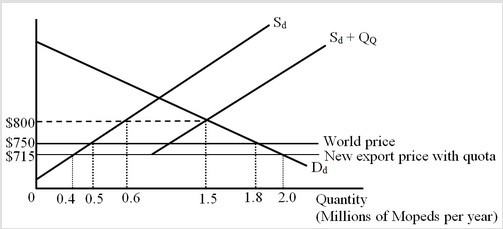The following figure shows the domestic demand (Dd) and domestic supply (Sd) curves of mopeds in a country before an import quota is imposed by the government. After the imposition of the quota, the maximum import quantity is QQ. After the quota is imposed, the domestic consumers
After the quota is imposed, the domestic consumers
A. lose $22.5 million.
B. gain $52.5 million.
C. lose $82.5 million.
D. lose $7.5 million.
Answer: C
You might also like to view...
Assuming a reserve ratio of 10 percent, if a bank receives $100,000 in deposits how much can the bank loan out?
A) $10,000 B) $90,000 C) $100,000 D) $110,000
In any efficiency wage model, it must be true that
a. the marginal benefit of increased efficiency is equal to the marginal cost of higher wages. b. nominal wages are inflexible. c. disequilibrium in the labor market exists. d. all of the above. e. none of the above.
If a third party pays for an individual to consume a good, how is the decision making of consumers affected? How does this affect the actions of suppliers?
Explain how firms' production functions and cost curves will change as science and technology advance and as the knowledge of how to organize and manage resources improves.
What will be an ideal response?